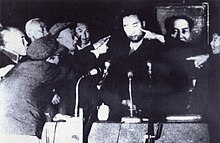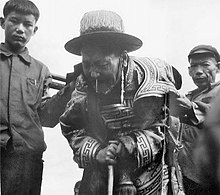Struggle session
| Struggle session | |||
|---|---|---|---|
 The 10th Panchen Lama during a struggle session | |||
| Chinese name | |||
| Simplified Chinese | 批斗大会 | ||
| Traditional Chinese | 批鬥大會 | ||
| |||
| Tibetan name | |||
| Tibetan | འཐབ་འཛིང | ||
| |||
Struggle sessions were a form of public humiliation and torture used by the Communist Party of China (CPC) at various times in the Mao era, particularly during the years immediately before and after the establishment of the People's Republic of China (PRC) and during the Cultural Revolution.[1][2] The aim of struggle sessions was to shape public opinion, as well as to humiliate, persecute, or execute political rivals and those deemed class enemies.[3]
In general, the victim of a struggle session was forced to admit various crimes before a crowd of people who would verbally and physically abuse the victim until they confessed. Struggle sessions were often held at the workplace of the accused, but they were sometimes conducted in sports stadiums where large crowds would gather if the target was well-known.[3]
History[]
Etymology[]


According to Lin Yutang, the expression comes from pīpàn (批判, 'to criticize and judge') and dòuzhēng (鬥爭, 'to fight and contest'), so the whole expression conveys the message of "inciting the spirit of judgment and fighting." Instead of saying the full phrase pīpàn dòuzhēng, it was shortened to pīdòu (批鬥).[citation needed]
The term refers to class struggle; the session is held, ostensibly, to benefit the target, by eliminating all traces of counterrevolutionary, reactionary thinking.
Origins and Speak Bitterness sessions[]
Struggle sessions developed from similar ideas of criticism and self-criticism in the Soviet Union from the 1920s. Chinese communists resisted this at first, as struggle sessions conflicted with the Chinese concept of 'saving face'. However, these sessions became commonplace at Chinese Communist Party (CCP) meetings during the 1930s due to public popularity.[4]
Struggle campaigns emerged in China as a tactic to secure the allegiance of the Chinese people during the land reform (土地改革, tǔdì gǎigé) campaign.[5] That campaign sought to mobilize the masses through intensive propaganda followed by Speak Bitterness sessions (訴苦, sùkǔ, 'give utterance to grief') in which peasants were encouraged to accuse land owners.
Development and disuse[]
The strongest accusations in the Speak Bitterness sessions were incorporated into scripted and stage-managed public mass accusation meetings (控訴大会, kòngsù dàhuì). Cadres then cemented the peasants’ loyalty by inducing them to actively participate in violent acts against landowners. Later struggle sessions were adapted to use outside the CCP as a means of consolidating its control of areas under its jurisdiction.[6][7][8]
Struggle sessions were disowned in China after 1978, when the reformers led by Deng Xiaoping took power. Starting from the "Boluan Fanzheng" period, Deng prohibited struggle sessions and other kinds of Mao-era violent political campaigns.[citation needed]
Purpose[]
Frederick T. C. Yu identified three categories of mass campaigns employed by the CCP in the years before and after the establishment of the People's Republic of China (PRC):[9]
- Economic campaigns sought to improve conditions, often by increasing production in particular sectors of the economy.
- Ideological campaigns sought to change people's thinking.
- Struggle campaigns were similar to ideological campaigns, but "their focus is on the elimination of the power base and/or class position of enemy classes or groups."[10]
The process of struggle sessions served multiple purposes. First, it demonstrated to the masses that the party was determined to subdue any opposition (generally labeled “class enemies”), by violence if necessary. Second, potential rivals were crushed. Third, those who attacked the targeted foes became complicit in the violence and hence invested in the state. All three served to consolidate the party's control, which was deemed necessary because party members constituted a small minority of China's population.[6][7][8]
Both accusation meetings and mass trials were largely propaganda tools to accomplish the party's aims. Klaus Mühlhahn, professor of China Studies at Freie Universität Berlin, wrote:
Carefully arranged and organized, the mass trials and accusatory meetings followed clear and meticulously prearranged patterns. Dramatic devices such as staging, props, working scripts, agitators, and climactic moments were used to efficiently engage the emotions of the audience—to stir up resentment against the targeted groups and mobilize the audience to support the regime.[11][12]
Julia C. Strauss observed that public tribunals were "but the visible dénouement of a show that had been many weeks in preparation".[13]
Accounts[]
Margaret Chu, writing retrospectively for the Cardinal Mindszenty Foundation's Mindszenty Report in November 1998, said:
[T]he Cultural Revolution began and I was transferred to another labor camp… Two years after I had been in this new camp, I received a parcel from my family. Immediately, an inmate accused me of giving something out of it to another prisoner. I was dragged to the office. Without any investigation, the officer assembled the entire camp to start a struggle session against me. In the session the officer suddenly asked me whether I had committed my alleged original crime leading to my 8-year sentence. I was stunned. It then dawned on me that this session was in fact prearranged. The parcel was only a pretense. Their real motive was once again to force me to admit all my alleged crimes. "I did not commit any crimes," I asserted firmly. Immediately two people jumped on me and cut off half of my hair. The officer screamed again: "are you guilty?" I replied firmly again, "no." Two people then used a rope to tie my hands back tightly. It was connected to a loop around my shoulder and underneath my armpits. It was knotted in such a way that a slight movement of my hands would cause intense pain. This struggle session lasted for two hours. Afterwards, they untied me and handcuffed me instead. The handcuffs became a part of me for the next one hundred days and nights...[14]
Anne F. Thurston, in Enemies of the People, gave a description of an infamous struggle session for the professor You Xiaoli:
You Xiaoli was standing, precariously balanced, on a stool. Her body was bent over from the waist into a right angle, and her arms, elbows stiff and straight, were behind her back, one hand grasping the other at the wrist. It was the position known as "doing the airplane." Around her neck was a heavy chain, and attached to the chain was a blackboard, a real blackboard, one that had been removed from a classroom at the university where You Xiaoli, for more than ten years, had served as a full professor. On both sides of the blackboard were chalked her name and the myriad crimes she was alleged to have committed...
The scene was taking place at the university, too, in a sports field at one of China's most prestigious institutions of higher learning. In the audience were You Xiaoli's students and colleagues and former friends. Workers from local factories and peasants from nearby communes had been bussed in for the spectacle. From the audience came repeated, rhythmic chants ... "down with You Xiaoli! Down with You Xiaoli!"
"I had many feelings at that struggle session," recalls You Xiaoli. "I thought there were some bad people in the audience. But I also thought there were many ignorant people, people who did not understand what was happening, so I pitied that kind of person. They brought workers and peasants into the meetings, and they could not understand what was happening. But I was also angry."[15]
See also[]
- Anti-Bolshevik League incident
- Campaign to Suppress Counterrevolutionaries
- Class warfare
- Futian incident
- Kangaroo court
- New People's Army
- Presumption of guilt
- Show trial
- Two Minutes Hate, from Orwell's Nineteen Eighty-Four
- United Red Army
References[]
| Wikimedia Commons has media related to Struggle session. |
- ^ Meeting, Association for Asian Studies (1990-01-01). Violence in China: Essays in Culture and Counterculture. SUNY Press. ISBN 978-0-7914-0113-2.
- ^ "第九章 颠倒乾坤的"文化大革命"". Renmin Wang (in Chinese). Retrieved 2021-04-18.
- ^ Jump up to: a b Lipman, Jonathan Neaman; Harrell, Stevan (1990). Violence in China: Essays in Culture and Counterculture. SUNY Press. pp. 154–157. ISBN 9780791401156. OCLC 18950000.
- ^ Priestland, David (2009). The Red Flag: A History of Communism. Grove Press. p. 246. ISBN 978-0-8021-1924-7.
- ^ Li, Lifeng (2015). "Rural Mobilization in the Chinese Communist Revolution: From the Anti-Japanese War to the Chinese Civil War". Journal of Modern Chinese History. 9 (1): 95–116. doi:10.1080/17535654.2015.1032391. S2CID 142690129.
- ^ Jump up to: a b Wu, Guo (March 2014). "Speaking Bitterness: Political Education in Land Reform and Military Training Under the CCP, 1947-1951". The Chinese Historical Review. 21 (1): 3–23. doi:10.1179/1547402X14Z.00000000026. S2CID 144044801.
- ^ Jump up to: a b Solomon, Richard H. (1971). Mao's Revolution and the Chinese Political Culture. Berkeley, CA: University of California Press. pp. 195–200. ISBN 9780520018068. OCLC 1014617521.
- ^ Jump up to: a b Perry, Elizabeth J. (2002). "Moving the Masses: Emotion Work in the Chinese Revolution". Mobilization. 7 (2): 111–128. doi:10.17813/maiq.7.2.70rg70l202524uw6.
- ^ Yu, Frederick T. C. (1967). "Campaigns, Communications, and Development in Communist China". In Lerner, Daniel (ed.). Communication and Change in the Developing Countries. Honolulu, HI: East-West Center Press. pp. 201–202. ISBN 9780824802172. OCLC 830080345.
- ^ Cell, Charles P. (1977). Revolution at Work: Mobilization Campaigns in China. New York: Academic Press. p. 9. ISBN 9780121647506. OCLC 2968117. (Summarization of Yu’s categories.)
- ^ Mühlhahn, Klaus (2009). Criminal Justice in China: A History. Cambridge, MA: Harvard University Press. pp. 182–183. ISBN 9780674033238. OCLC 938707409.
- ^ Also, Strauss, Julia (December 2006). "Morality, Coercion and State Building by Campaign in the Early PRC: Regime Consolidation and After, 1949-1956". The China Quarterly. No. 188. pp. 906–908.
- ^ Strauss, Julia C. (2011). "Traitors, Terror, and Regime Consolidation on the Two Sides of the Taiwan Straits: 'Revolutionaries' and 'Reactionaries' from 1949 to 1956". In Thiranagama, Sharika; Kelly, Tobias (eds.). Traitors: Suspicion, Intimacy, and the Ethics of State-Building. Philadelphia, PA: University of Pennsylvania Press. p. 105. ISBN 9780812242133. OCLC 690379541.
- ^ "A Catholic Voice Out of Communist China - November 1998 Mindszenty Report". 2008-03-13. Archived from the original on 2008-03-13. Retrieved 2011-03-07.
- ^ "Enemies of the People". World and ischool. June 1987. Retrieved 2011-03-07.
- Campaigns of the Chinese Communist Party
- Cultural Revolution
- Group processes
- Maoist China
- Maoist terminology
- Meetings
- Political repression in China
- Vigilantism
- Crowd psychology
- Torture in China
- Mass hysteria
